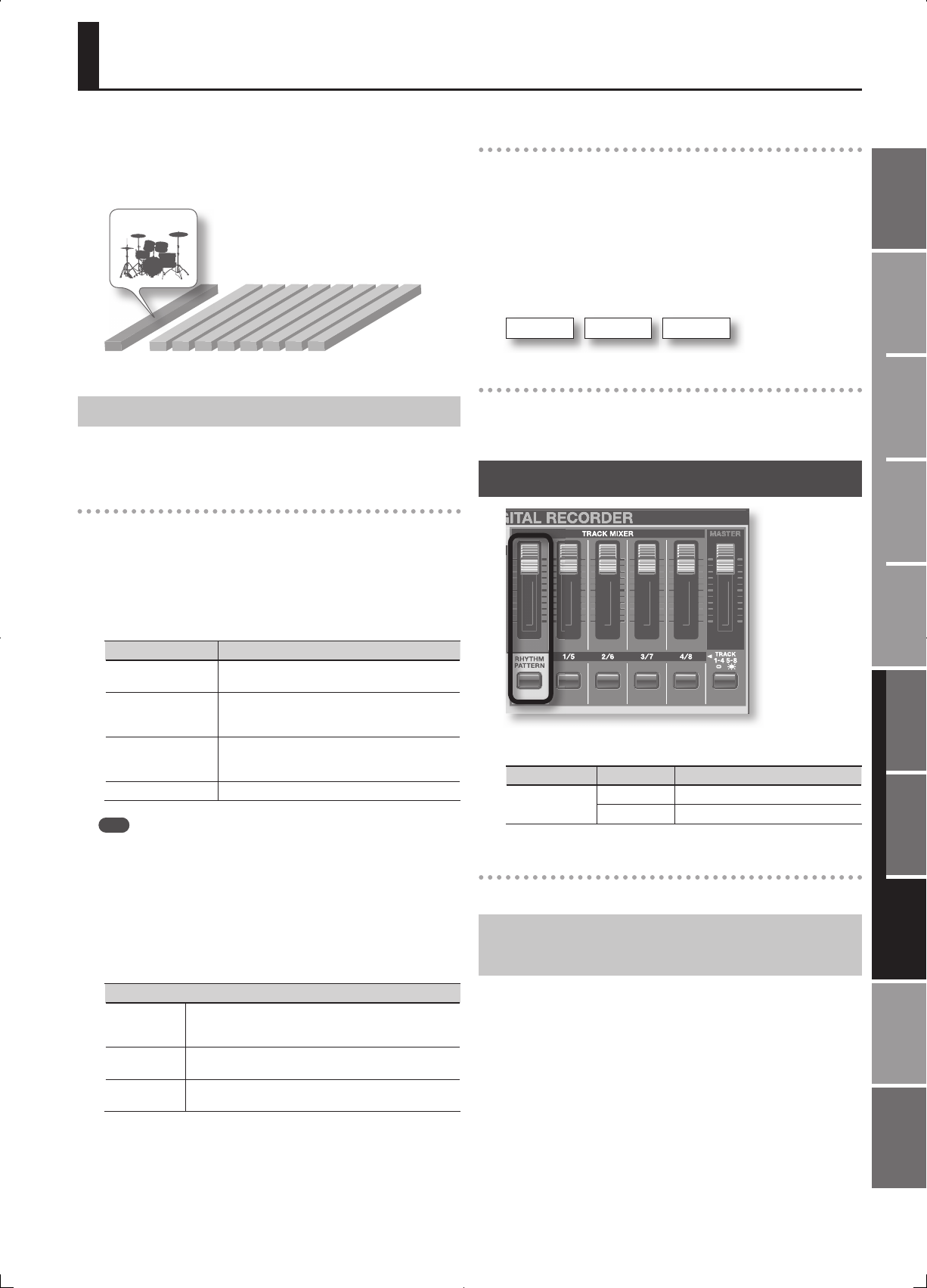
121
Overview
Appendix
USB Memory
Song Player
Digital Recorder
Synthesizer
Selecting Sounds Perform. Functions Editing/Eects Other Settings
Rec/Play/Edit Eects Rhythm Pattern
The JUNO-Gi provides a dedicated rhythm track in addition to its audio
tracks 1–8.
You can play rhythms as a guide during recording, or place internal
rhythms in the order of your song structure to create your own original
rhythm.
1 2 3 4 5 6 7 8
Rhythm Pattern
About Patterns and Arrangements
Broadly speaking, the JUNO-Gi’s rhythms consist of performance data
called “patterns” and “arrangements.”
What is a pattern?
If you’re a drummer playing in a band, you will normally repeat xed
patterns that are one or two measures in length. These are the basic
units of repetition, and are called “patterns” on the JUNO-Gi.
You can also edit a pattern to create your own original rhythm pattern.
The JUNO-Gi contains various patterns created for use in the
introduction, verse, ll, and ending. The pattern type is indicated by
the letters at the end of the pattern name.
Pattern Explanation
IN (Intro)
A performance pattern for use during an
introduction.
V (Verse) 1, 2
These are the main performance patterns. 1 is the
basic pattern, and 2 is a more advanced variation
of 1.
F (Fill) 1, 2
These are performance patterns typically inserted
at transitions between phrases. Choose either 1 or 2
depending on the pattern that will follow the ll.
E (Ending) A performance pattern used at the end of the song.
Ex.
• ROCK1-IN (Intro)
• ROCK1-V1 (Verse 1)
• ROCK1-F1 (Fill 1)
• ROCK1-V2 (Verse 2)
• ROCK1-F2 (Fill 2)
• ROCK1-E (Ending)
The patterns are organized into the following groups.
Pattern Group
PRESET
These are preset patterns that cannot be rewritten.
However, you are free to edit the currently selected pattern,
and then save it as a User or Song pattern.
USER
These patterns are saved in the JUNO-Gi’s internal memory.
These patterns can be used by multiple songs.
SONG
These patterns are saved as part of the song.
These patterns cannot be used in other songs.
What is an arrangement?
You could let a certain pattern repeat endlessly and practice along
with it, just as though you were playing along with a metronome.
However, using just a single pattern from the beginning of the song to
its end would make the rhythm rather boring!
To give your song greater musical variety, you’ll probably want to
arrange patterns in order, such as: intro g chorus g break g ending.
A sequence of patterns that are placed in a performance order such as
this is called an “arrangement.”
Each song can store one arrangement.
Intro Verse Fill
• • •
What is an rhythm set?
A “rhythm set” is the set of drum sounds that are played by the pattern/
arrangement.
For each song, one Rhythm Set number is remembered.
Turning the Rhythm Pattern On/O
1. Press the [RHYTHM PATTERN] button to turn the Rhythm
Pattern on/o .
Button State Explanation
[RHYTHM
PATTERN]
Unlit Rhythm Pattern function is o
Lit green Rhythm Pattern function is on
Adjusting the volume of the Rhythm Pattern
1. Use the [RHYTHM PATTERN] slider to adjust the volume.
Editing the Pan, Reverb, and EQ of the
Rhythm Pattern
Refer to “Adjusting the Pan, Reverb, and EQ (TRACK SETTING)” (p. 89).
Digital Recorder 3 (Rhythm Pattern)
Playing a Rhythm Pattern


















